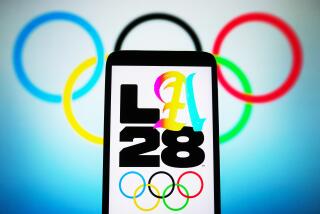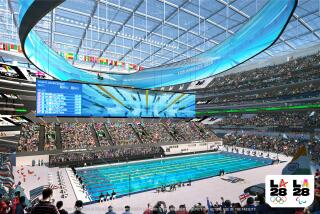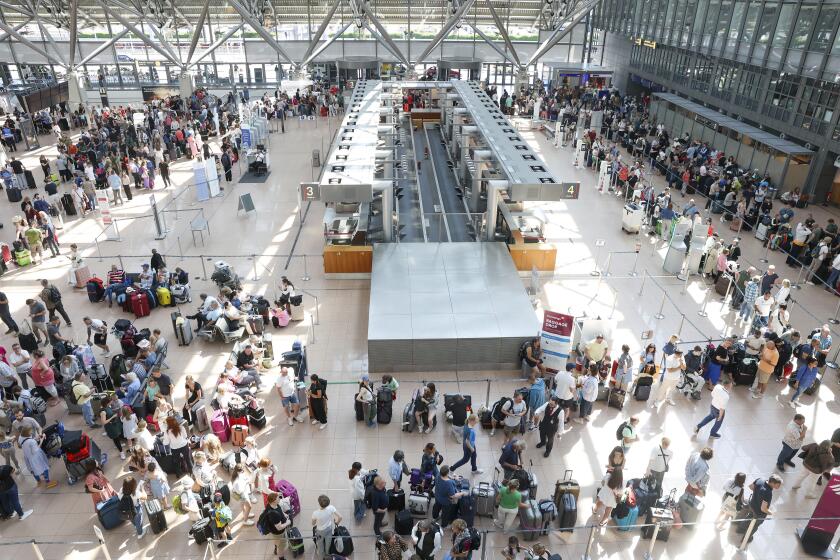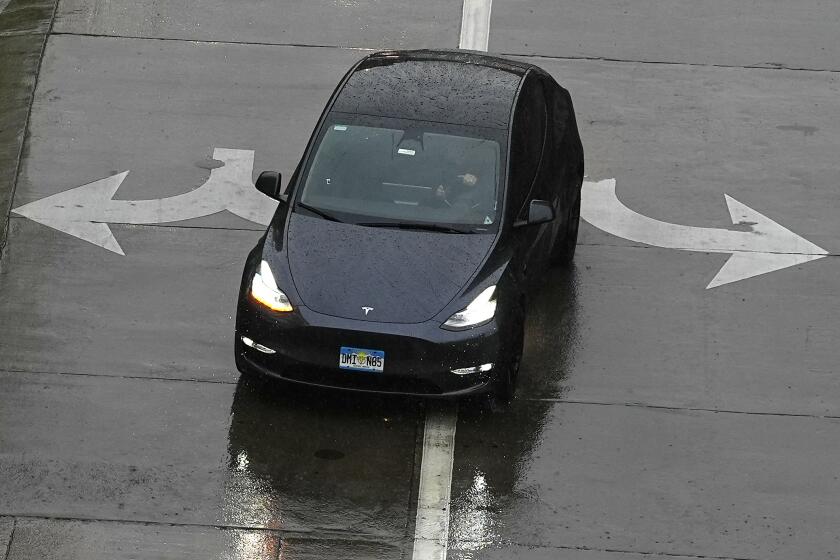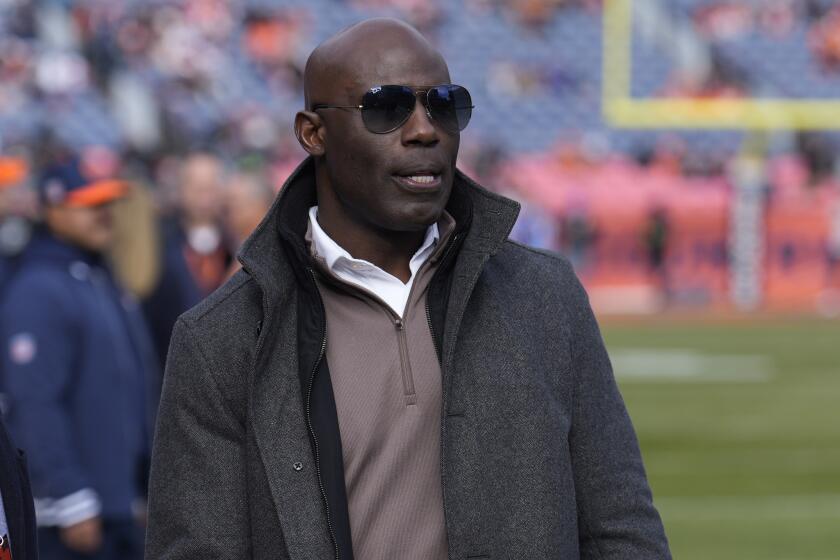A Rocky Road for Traffic Planners : How to Ease the Gridlock? ’84 Olympic Experience Provides Elusive Model
It was a magic time. For 16 days in the summer of 1984, driving to work seemed almost a joy--and then the XXIII Olympiad came to an end, officially closed by Los Angeles Mayor Tom Bradley with a prophetic quip: “The Games are over, let the traffic begin.”
The next day the freeways were congested, the rutted surface streets bumpy and crowded as ever. Five years later, the congestion has only grown worse, and politicians, traffic experts and commuters can only look back longingly on the Olympic traffic-management plans and wonder why those same, relatively simple tactics cannot be resurrected.
There are many answers to that seemingly straightforward proposition and, together, they help to make clear the complex transportation equation that has brought the Los Angeles Basin to the brink of gridlock.
No Central Authority
Mainly, traffic experts point to the absence of a central authority with influence over a confusing number of governmental agencies that control the maze of freeways and streets. The Los Angeles Olympic Organizing Committee seized the leadership role, bringing together for the first time the hodgepodge of agencies that collectively--though rarely in harmony--set the region’s traffic policies.
The Olympic planners had the time and resources to attempt only a quick fix. Their strategy was to smooth out the flow so that overcrowded roadways would carry more people. To do this, they relied heavily on persuading drivers to change their habits, to delay trips, to car pool, even to ride the bus.
Like a shot of painkilling Novocain, this attempt at traffic management worked for a short time. However, most Southern California motorists over the long haul insist on traveling alone, making fuller implementation of the Olympic plan difficult, if not impossible.
Costly Projects
Some experts believe the only solutions lie not in attempting to manage or at least massage traffic flows, but in more tangible--and costly--projects, such as increased freeway construction.
Bradley and others have pushed to make portions of the Olympic traffic management plan permanent. Boxed in by jurisdictional borders, they have been able to do this only in a piecemeal fashion that, at best, will squeeze a relatively few more cars onto the roadways. These additions, by themselves, promise little hope for regionwide results, critics say.
The real trick in traffic management is to squeeze more people into fewer cars--or buses--a goal that has proven elusive despite dire forecasts of the traffic system’s pending collapse. Simply by raising the average number of people riding in each vehicle to 1.7--up only half a tick from the normal average of 1.2 people--would free up the freeways, various transportation experts agreed in interviews. The proof, they said, was in the Olympic traffic management experience, which, unfortunately, few believe can be duplicated.
The “unqualified success” of the Olympic plan was a one-time happening that has “very limited transferability,” said Genevieve Giuliano, a traffic specialist who investigated the Olympic management systems for the University of California’s Institute of Transportation Studies. The successes, she noted in the most extensive report on the Olympic traffic plan, were both “unique and short-term.”
Red Tape Cut
Giuliano, who teaches urban planning at USC, said the Olympic planners succeeded because they could cut red tape and make quick decisions.
“Everyday conflicts between local agencies were forgotten,” she reported. “Cooperation and leadership made it possible to implement policies that under normal conditions would be unacceptable and . . . with the exception of the synchronized signal system in downtown Los Angeles . . . none of the strategies survived.”
Said Assemblyman Richard Katz (D-Sepulveda), chairman of the Assembly Transportation Committee: “You need a dominant personality, like Peter Ueberroth, to make it work . . . (someone) who is willing to do what it takes to get the job done” but who doesn’t have to worry about a constituency or getting reelected.
When the Olympic Transportation Advisory Group first met in 1981, it faced the unprecedented challenge of accommodating an expected 1.2 million visitors and 6 million spectators on already congested streets and freeways. The group--composed of top managers from private corporations and public agencies--was brought together by Harry Usher, general manager of the Olympic Organizing Committee, who told them to do whatever was necessary to make the traffic flow.
Significantly, many of those public transportation officials were meeting together for the first time.
“Some of these people had never even talked before,” said Usher, a lawyer who now runs a downtown office of a national headhunting firm.
Fronts of Attack
The plan attacked traffic on many fronts. Employers were asked to shorten work weeks, offer flextime hours and establish car pools. Truckers were urged to make deliveries at night. State and local agencies adopted numerous small changes to milk more capacity out of the crowded streets and freeways. For instance, during the Games, law enforcement agencies and crash-cleanup teams were on full alert.
“On those first days of the Games, there was zero congestion,” said Dave Roper, Los Angeles division chief of operations for the California Department of Transportation. “Traffic was down 4% at first, but by mid-Olympics . . . we were carrying 7% more traffic . . . without problems.”
Cooperation extended to commuters themselves. During the Olympics, people shared rides and signed up for hastily organized van pools. Some even gave up their cars to ride the bus, or altered their work schedules to commute during off hours. Olympics spectators found the outlying park-and-ride lots and took special buses to events along express routes.
“This atmosphere of cooperation and leadership made it possible to implement policies that, under normal conditions, would be unacceptable,” said USC’s Giuliano. After the Olympics, “The institutional conflicts resurfaced . . . and the Olympics (traffic) program proved to be no longer feasible under ordinary circumstances.”
Giuliano found that suspension of rules requiring public hearings, environmental impact reports and similar regulatory safeguards will be tolerated only on a temporary basis. It was permissible then to ban curb-side parking, opening an additional traffic lane and creating one-way streets for 16 days, but to make these changes permanent would be politically controversial.
Motivating Forces
Absent during ordinary times are two of the more powerful motivating forces that drove Southern California commuters and officials to cooperate with the Olympic plan, which was backed by relatively little jurisdictional clout. One was civic pride. The other was fear. And the Olympic planners played to both, reminding Southern California continually that the world would be watching and making dark forecasts of traffic chaos on particularly active Olympic days, one of which they dubbed “Black Monday.”
Those immediate motivations are gone now, and most motorists swallow the daily traffic jam as a routine part of Los Angeles life.
“I’m amazed at the amount of congestion people will tolerate,” Giuliano said.
Most traffic experts agree that the Olympic solutions were short-term fixes, Band-Aids really and not the treatments needed to heal Southern California transportation ills. What these treatments should be is still hotly debated.
Much of the debate centers on whether to build new freeways or switch priorities to mass transit systems. California was once a transportation leader. For years, no other state spent so much on highways, but all of that has changed. After a decade of budget cuts, new transportation construction has lagged far behind unrestrained urban growth.
The Automobile Club of Southern California wants $22.5 billion spent to modernize the old freeways and to build new ones as a remedy “to a decade of neglect.” The club opposes trolley cars and says commuter trains are expensive follies.
Transit System
More freeways are not the answer, according to James Gosnell, a transportation expert from the Southern California Assn. of Governments, a regional planning agency. “There isn’t enough money, sand and gravel to build all the freeways we need,” Gosnell said. He favors “a massive (rail) transit system.”
While highway spending is way down, the number of registered vehicles in California has shot up to 24 million, outstripping the population growth 3 to 1 during the last two decades. With more people driving, congestion is compounding at a pace of 15% a year, Caltrans reports. Some freeways are carrying 140% of their capacity, and most cars are carrying only the driver.
While the experts debate freeways versus subways, not everyone agrees that the Olympic experience, or at least parts of it, should be overlooked as a possible solution.
Bradley and the City Council have started a $200-million expansion of the computerized, automatic traffic signal system that was developed to free up the flow of cars around the Olympic venues. The mayor talks of implementing “the total 1984 Olympic transit plan,” although his authority--unlike that assumed by the LAOOC officials--does not exceed the boundaries of Los Angeles.
Gov. George Deukmejian wants to “unlock the gridlock,” by building super-freeways, complete with double-deck bus and van pool lanes, and by finding ways to “make wiser use” of the state’s “excellent transportation network.” This includes making use of the high-tech traffic management techniques developed to ease Olympics congestion.
Automated System
“We are trying to apply (the Olympic experience) across the board,” said John Geogahegan, secretary of the state’s Business, Transportation and Housing Agency and Deukmejian’s transportation point man.
The automated traffic signal system, designed and operated by the Los Angeles Department of Transportation just for the Games, linked sensors embedded in the streets to computers and signal-timing devices so that, when traffic backed up, the timing on the signal lights changed, leaving the green lights on longer to keep the cars moving.
This system--a nationally recognized example of high-tech traffic management--has since been expanded to cover the entire downtown area. City officials say all 3,800 of the city’s signaled intersections eventually will be linked.
Caltrans has a similar command center in the state office building downtown. Sensors embedded in the freeways and on-ramps send signals to an electronic map of the 700-mile freeway network that covers one wall in the center. Automatic on-ramp meters adjust the flow of traffic into the system. Caltrans and California Highway Patrol teams monitor the flow and dispatch emergency-response teams to push stalls out of the way and clean up wrecks. During the Olympics, the system was expanded.
These two traffic-management systems will soon be linked in a $40-million, multiagency experiment designed to ease congestion on the Santa Monica Freeway. The combined system will monitor traffic and, when congestion builds, traffic will automatically be diverted off the freeway onto parallel surface streets, where automated signals will keep things moving. Beefed-up “incident-response” teams will clear wrecks or stalls, the designers say.
Trucking Proposals
During the Olympics, many truckers, shippers and receivers agreed to nighttime deliveries, reducing the number of trucks on the streets at rush hour. Bradley wants to duplicate that program permanently by imposing permits and restrictions on larger trucking firms. The state is also considering ways to reduce peak-time truck traffic on freeways.
Although trucks make up only 4% of the traffic flow on the freeways and surface streets, studies show that truck accidents, stalls and spilled loads account for up to 20% of the congestion. In Los Angeles, that congestion costs the motoring public $189 million a year, most of it in time lost in traffic jams, studies show.
Truckers don’t like the idea of restricted night deliveries.
“It’s messing around with social issues . . . you can’t flip-flop society like that,” said Thomas C. Schumacher Jr., general manager of the California Trucking Assn. He pointed out that truckers voluntarily did their part during the Olympics and are willing to work out similar, short-term arrangements where needed, but they oppose mandatory controls.
Ride-sharing has always been a sought-after but elusive method of filling empty automobile seats during commute times.
Olympic officials did steer employers toward temporary van pools and ride-sharing plans. Faced with tougher clean-air regulations, major employers are putting together similar plans or joining private, nonprofit traffic management associations to encourage ride-sharing among employees.
Deukmejian has created an Office of Traffic Improvement to persuade at least 10% of the state’s 230,000 employees that they should leave their cars at home. Like private companies, the state’s ride-share program offers cash incentives, time off and other inducements.
Each of these efforts is a piecemeal attempt to chip away at the increasing congestion, without addressing what many view as the underlying problem: unrestrained urban growth. Privately, most traffic experts agree on this, but “growth management” is such a politically charged subject that they are reluctant to talk openly about it.
“We need more money, true, but we can’t buy our way out of these problems,” said one of these experts, on the condition that he not be identified. “We can’t build enough freeways or transit systems. What’s required is better planning for congestion reduction--in other words, growth management.”
More to Read
Go beyond the scoreboard
Get the latest on L.A.'s teams in the daily Sports Report newsletter.
You may occasionally receive promotional content from the Los Angeles Times.
